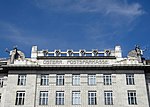Uniqa Tower
2000s architectureCommons category link is locally definedLeopoldstadtSkyscrapers in EuropeSkyscrapers in Vienna

The Uniqa Tower (owner's spelling: UNIQA Tower) is an office building on the Danube Canal in Leopoldstadt, the 2nd district of Vienna. The building received the European Union Green Building label. It is the first building in Austria and one of the first buildings in Europe to bear the label.
Excerpt from the Wikipedia article Uniqa Tower (License: CC BY-SA 3.0, Authors, Images).Uniqa Tower
Untere Donaustraße, Vienna KG Leopoldstadt (Leopoldstadt)
Geographical coordinates (GPS) Address Phone number Website Nearby Places Show on map
Geographical coordinates (GPS)
| Latitude | Longitude |
|---|---|
| N 48.2128 ° | E 16.3836 ° |
Address
UNIQA Österreich Versicherungen AG
Untere Donaustraße 21
1020 Vienna, KG Leopoldstadt (Leopoldstadt)
Austria
Open on Google Maps










